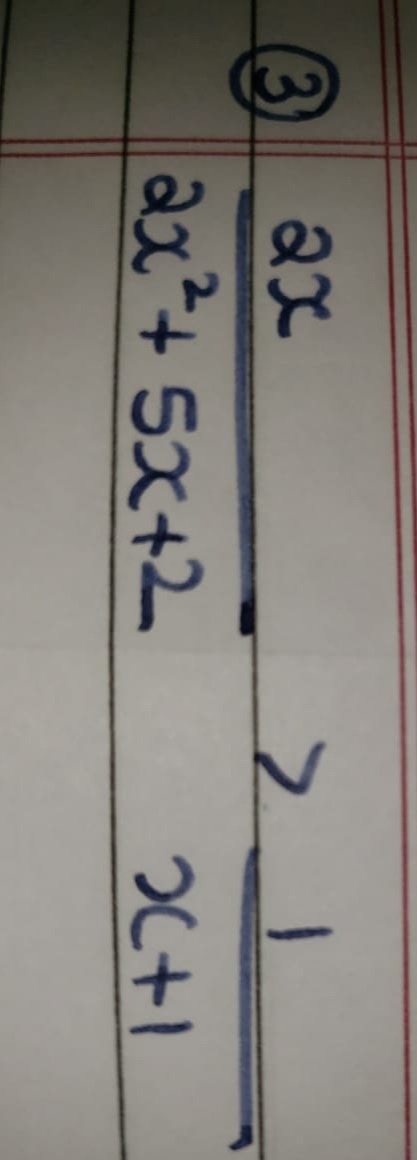Question
Question: $\frac{2x}{x^2+5x+2} \geq \frac{1}{x+1}$...
x2+5x+22x≥x+11

x∈(2−5−17,−1)∪[23−17,2−5+17)∪[23+17,∞)
Solution
We wish to solve
x2+5x+22x≥x+11.Step 1. Bring all terms to one side
x2+5x+22x−x+11≥0.Step 2. Write as a single rational expression
The common denominator is (x2+5x+2)(x+1) (note that x+1=0 and x2+5x+2=0). Thus,
(x2+5x+2)(x+1)2x(x+1)−(x2+5x+2)≥0.Simplify the numerator:
2x(x+1)−(x2+5x+2)=2x2+2x−x2−5x−2=x2−3x−2.So the inequality becomes
(x2+5x+2)(x+1)x2−3x−2≥0.Step 3. Find the critical points
-
Zeros of the numerator: Solve
x2−3x−2=0⟹x=23±9+8=23±17.Let
r1=23−17andr2=23+17.Numerically, r1≈−0.56 and r2≈3.56.
-
Zeros of the factor x+1: x=−1.
-
Zeros of x2+5x+2: Solve
x2+5x+2=0⟹x=2−5±25−8=2−5±17.Let
p1=2−5−17≈−4.56,p2=2−5+17≈−0.44.
Remember that the expression is undefined when the denominator is zero, i.e. at x=−1, x=p1 and x=p2.
Step 4. Determine the sign in the various intervals
The critical points (in increasing order) are:
p1≈−4.56,−1,r1≈−0.56,p2≈−0.44,r2≈3.56.Thus, the real line is divided into these intervals:
- x<p1
- (p1,−1)
- (−1,r1)
- (r1,p2)
- (p2,r2)
- x>r2
Using test points in each interval (details omitted for brevity), one finds that the expression is nonnegative (i.e. positive or 0) in the intervals:
- (p1,−1)
- (r1,p2) (note that at x=r1 the numerator is zero and it is allowed provided the denominator is nonzero)
- (r2,∞) (with equality at x=r2).
Step 5. Write the final answer, taking care to exclude points where the denominator is 0
Thus the solution set is:
x\in\left(\frac{-5-\sqrt{17}}{2},\,-1\right)\cup\left[\frac{3-\sqrt{17}}{2},\,\frac{-5+\sqrt{17}}{2}\right)\cup\left[\frac{3+\sqrt{17}}{2},\,\infty\right) $$. **Summary** - **Core Explanation:** 1. Bring all terms to one side. 2. Combine into a single rational expression. 3. Find zeros of the numerator and denominator. 4. Use a sign chart to find intervals where the expression is nonnegative. 5. Exclude values that make the denominator 0. - **Final Answer:** $$ x\in\left(\frac{-5-\sqrt{17}}{2},\,-1\right)\cup\left[\frac{3-\sqrt{17}}{2},\,\frac{-5+\sqrt{17}}{2}\right)\cup\left[\frac{3+\sqrt{17}}{2},\,\infty\right) $$